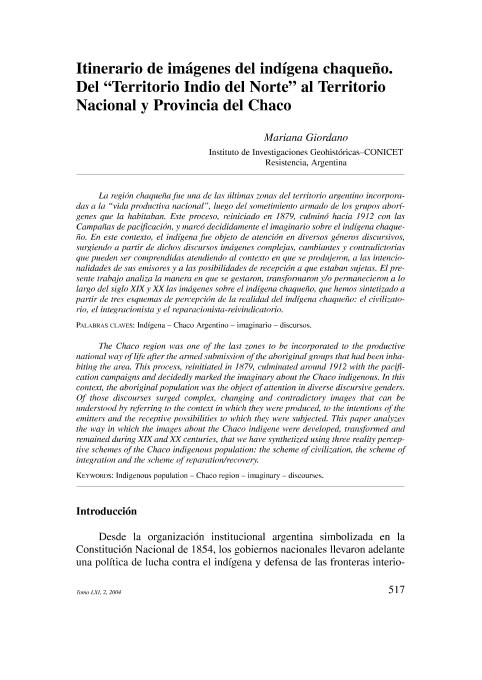Mostrar el registro sencillo del ítem
dc.contributor.author
Giordano, Mariana Lilian

dc.date.available
2017-09-14T19:59:26Z
dc.date.issued
2004-12
dc.identifier.citation
Giordano, Mariana Lilian; Itinerario de imágenes del indígena chaqueño. Del “Territorio Indio del Norte” al Territorio Nacional y Provincia del Chaco; Consejo Superior de Investigaciones Científicas. Escuela de Estudios Hispano-Americanos; Anuario de Estudios Americanos; 61; 2; 12-2004; 517-550
dc.identifier.issn
0210-5810
dc.identifier.uri
http://hdl.handle.net/11336/24298
dc.description.abstract
La región chaqueña fue una de las últimas zonas del territorio argentino incorporadas a la “vida productiva nacional”, luego del sometimiento armado de los grupos aborígenes que la habitaban. Este proceso, reiniciado en 1879, culminó hacia 1912 con las Campañas de pacificación, y marcó decididamente el imaginario sobre el indígena chaqueño. En este contexto, el indígena fue objeto de atención en diversos géneros discursivos, surgiendo a partir de dichos discursos imágenes complejas, cambiantes y contradictorias que pueden ser comprendidas atendiendo al contexto en que se produjeron, a las intencionalidades de sus emisores y a las posibilidades de recepción a que estaban sujetas. El presente trabajo analiza la manera en que se gestaron, transformaron y/o permanecieron a lo largo del siglo XIX y XX las imágenes sobre el indígena chaqueño, que hemos sintetizado a partir de tres esquemas de percepción de la realidad del indígena chaqueño: el civilizatorio, el integracionista y el reparacionista-reivindicatorio.
dc.description.abstract
The Chaco region was one of the last zones to be incorporated to the productive national way of life after the armed submission of the aboriginal groups that had been inhabiting the area. This process, reinitiated in 1879, culminated around 1912 with the pacification campaigns and decidedly marked the imaginary about the Chaco indigenous. In this context, the aboriginal population was the object of attention in diverse discursive genders. Of those discourses surged complex, changing and contradictory images that can be understood by referring to the context in which they were produced, to the intentions of the emitters and the receptive possibilities to which they were subjected. This paper analyzes the way in which the images about the Chaco indigene were developed, transformed and remained during XIX and XX centuries, that we have synthetized using three reality perceptive schemes of the Chaco indigenous population: the scheme of civilization, the scheme of integration and the scheme of reparation/recovery.
dc.format
application/pdf
dc.language.iso
spa
dc.publisher
Consejo Superior de Investigaciones Científicas. Escuela de Estudios Hispano-Americanos
dc.rights
info:eu-repo/semantics/openAccess
dc.rights.uri
https://creativecommons.org/licenses/by/2.5/ar/
dc.subject
Indígena
dc.subject
Chaco Argentino
dc.subject
Imaginario
dc.subject
Discursos
dc.subject.classification
Arqueología

dc.subject.classification
Historia y Arqueología

dc.subject.classification
HUMANIDADES

dc.title
Itinerario de imágenes del indígena chaqueño. Del “Territorio Indio del Norte” al Territorio Nacional y Provincia del Chaco
dc.type
info:eu-repo/semantics/article
dc.type
info:ar-repo/semantics/artículo
dc.type
info:eu-repo/semantics/publishedVersion
dc.date.updated
2017-09-01T18:13:13Z
dc.identifier.eissn
1988-4273
dc.journal.volume
61
dc.journal.number
2
dc.journal.pagination
517-550
dc.journal.pais
España

dc.journal.ciudad
Sevilla
dc.description.fil
Fil: Giordano, Mariana Lilian. Consejo Nacional de Investigaciones Científicas y Técnicas. Centro Científico Tecnológico Conicet - Nordeste. Instituto de Investigaciones Geohistóricas. Universidad Nacional del Nordeste. Instituto de Investigaciones Geohistóricas; Argentina
dc.journal.title
Anuario de Estudios Americanos
dc.relation.alternativeid
info:eu-repo/semantics/altIdentifier/url/http://estudiosamericanos.revistas.csic.es/index.php/estudiosamericanos/article/view/131
dc.relation.alternativeid
info:eu-repo/semantics/altIdentifier/doi/http://dx.doi.org/10.3989/aeamer.2004.v61.i2.131
Archivos asociados
